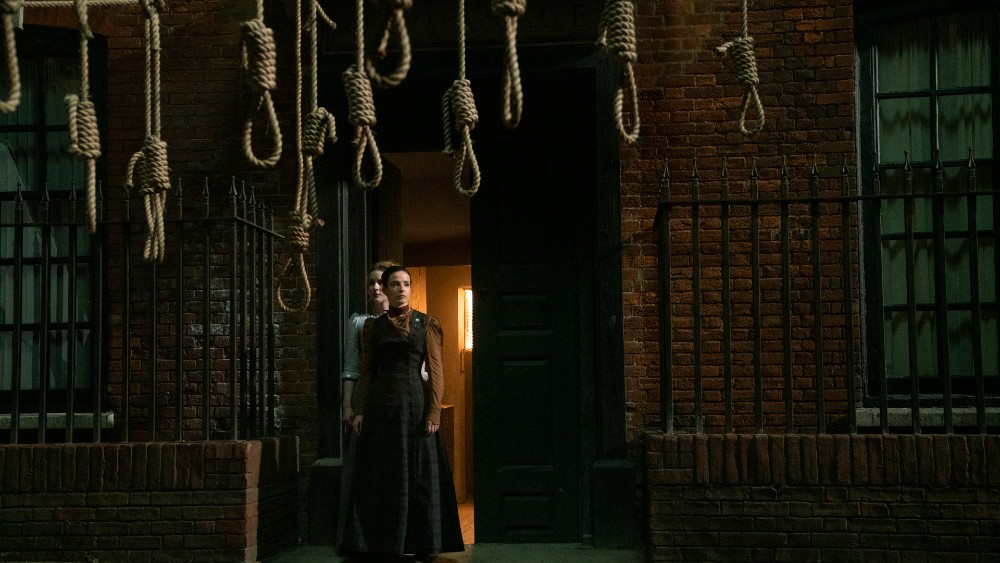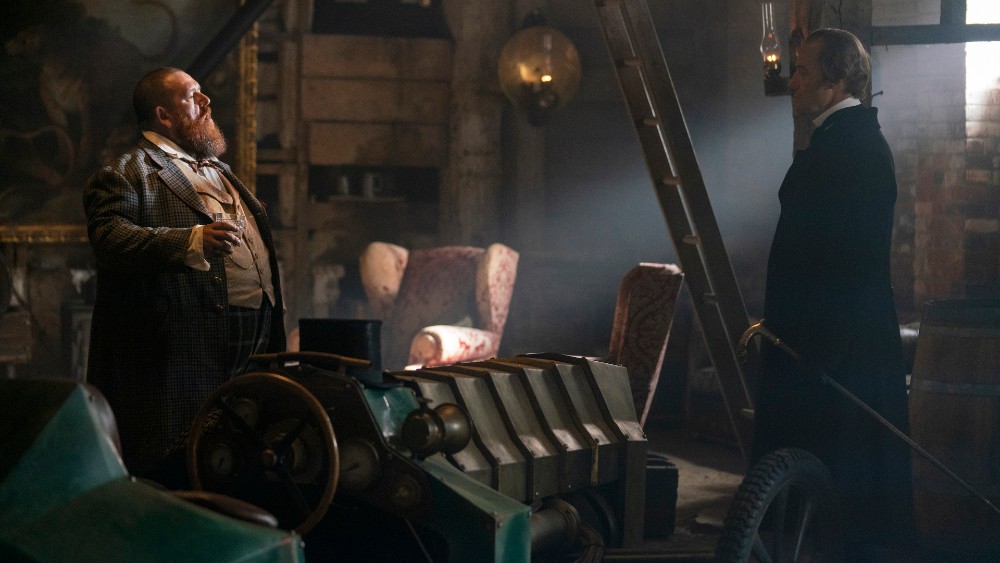
Picture a Victorian London where a certain few “Touched” have been given extraordinary powers: superhuman strength, the ability to predict the future, the power to heal wounds. They pose a huge threat to an addled male patriarchy. In The Nevers, Writer and Director Joss Whedon explores what happens when the known world careens into the unknown.
Creating that new world was the job of Production Designer Gemma Jackson and Set Decorator Tina Jones, both veterans of HBO’s Game of Thrones. Jackson’s resume includes the John Adams miniseries, as well as period features like The Winslow Boy. Jones has worked on projects as diverse as Spider-Man: Far from Home and Disney’s live-action Pinocchio.
They spoke with Below the Line by telephone.

Below the Line: At what stage did you join The Nevers?
Gemma Jackson: I was the first one in, production design usually goes in quite early in the process. I met up with Joss and read his notes and scripts. We started looking at references for the period, every aspect we could think of that might be important. I also brought Tina on as soon as I could, because I find the art department and set dressing to be part of one big process that we do together.
We did a huge amount of research, we looked into every aspect of Victorian life. It wasn’t just how people sat around their dining room table, but what they ate, when they ate it. Also the different areas and levels of society, the people down by the river, the police. So many aspects that would be coming up was what we researched. That’s how we got going.
BTL: How do you reach a consensus with Whedon about what the series will look like?
Jackson: Tina and I start with concept art, Tina for all her extraordinary gadgets that populate the show. I try to create an environment to bring to Joss. We’ve learned over the years that if somebody doesn’t know quite what they want — and very often directors don’t know — they do know what they don’t want. So you bring them as many different ideas as you can to give them something to chew on.
We build models if we can. I find three-dimensional models really help people understand the space you’re trying to create.

Tina Jones: It helped that Joss was so open to the ideas we came up with. For instance the car that appears in the first episode, we did concept art, then we made a small, 3D scale model. So Joss was able to hold it and see the proportions, tweak what he wanted. When I think back to the design process of the motor cars, he left it very much to us.
Jackson: Tina’s got a really good concept artist, so we could present Joss with detailed elements to help him put things together and envision the world we’re giving him. I think he had a vague idea of “Victorian London,” and then we astonished him.
Of course we had to work out how people would move in space, how he might work. He might say, “That’s not what it seemed like,” I might have designed a big space when he wanted something small and claustrophobic. There were times like that, but on the whole he went with our vision — which really grew with the show. One thing led to another thing, and the world just grew and grew and grew. And now we’re trying to grow the other half of it.
BTL: How do you two work together?
Jackson: So many people just sit behind a drawing board, but I’m not that designer. I like to get out and find things, things that speak to you and set you off on a journey, a visual experience.
Jones: We had so much fun at antique fairs, auctions, and markets.
Jackson: We go together, we love finding stuff together.
Jones: There was one really big antique fair that we went to where Gemma found a chair. She said, “I love this chair!” and I’m like, “Hmm, I’m not so sure.” But actually it inspired a whole set, the texture and color of the chair was reflected in the interior .
You become entwined with the characters. When you’re designing, thinking about decorating Amalia’s [played by Laura Donnelly] bedroom, for example, you think about her as a person, and what she would have actually chosen, selected for her room.

BTL: The Nevers has an amazing sense of scope and scale.
Jackson: It was really exciting, to be honest with you. HBO obviously decided that they were going to let us really let go on this thing. We were able to create a lot of wonderful worlds. That whole long street in the first episode, where the car emerges from a carriage, was a huge undertaking. We needed to create a main street, and there was nowhere in London or anywhere else really where you’ve got that stretch of period buildings anymore. You have to do it yourself now.
So it was a huge bonus to be able to give the place scale and set things up. We shot that a couple of hours outside London, in a place called Chatham.
We also had this amazing place, Langleybury, which has a huge house and massive grounds. It’s where we filmed the orphanage. It became a kind of backlot, which meant we could build streets and alleys sort of to suit the action that Joss wanted.
It helped us evolve this world, myself and Tina and Peter Russell, the Supervising Art Director, we created our own London that became stronger and more elaborate. The more we built, the more it became ours. We had a shopping street, alleys, and a covered market area.
If you’re always on location, there’s something about the rigidity of those walls, the things you can’t touch. When you can actually build things, like the narrow alleyways where Amalia walks up and down with her buns, you can really push reality a little.
Jackson: Seamus McGarvey, the Cinematographer, was there from the beginning. He and Tina would discuss lighting.
Jones: Especially on a period production, I like to be able to show the DoP lights that are right for the period, their potential shapes and sizes. We did a show and tell for Seamus on gas lighting, oil lighting, electrical lighting, all the different types we could think of. It was good for us as well, because he was able to determine whether to use real oil lights or pretend.
Jackson: The Costume Designer, Michele Clapton, I’ve worked with before. We have a good understanding of each other’s taste. With the Visual Effects Supervisor Johnny Han, again, I know it sounds rather nauseating, but to be honest with you we all got along and communicated very well.
Jones: Michele would show us what she was thinking of, and we showed her any concept art or dressing or decoration we were going to put in.

BTL: How much time did you have per episode? And were you working throughout the shoot?
Jones: With a show like this, there is so much detail that you’re building and dressing the whole time. Once they started shooting you only had three weeks and then they were into the next episode. So you had to keep ahead of the game. Also the scripts were a bit slow in coming.
Jackson: Every episode had so many elements that we didn’t have much time to hang about. We were always on tomorrow, tomorrow, tomorrow. We’d go every morning and make sure everything was set up for the day and that Joss was happy and Rachel Aulton, our standby art director, was happy, and then we’d be roaring off to the next thing.
BTL: Did the pandemic cause any problems?
Jones: We started back on July 4, mid-pandemic. The production was remarkably free from problems, we were pretty efficient here with checks and all that business.
Jackson: We were going to do the hanging scene in Greenwich, and then with Coronavirus, it suddenly became difficult. But that gave us the opportunity to build it, which was much, much better. We built it from scratch, a massive build, again on the grounds of Langleybury. Despite all the costs of construction, you’re not having to pay inner-city parking fees and location fees and stuff. What we saved on that they gave me to build. And we had so much more control over those complicated electrical issues.
Jones: I did find that it was difficult being able to hear people in meetings with all the masks. And it was quite hard to read people. You don’t realize how much you rely on somebody smiling to determine whether they liked something or not. In a way you strove slightly harder because you wanted to get a reaction with the eyes, because that’s all you could go by.
The first six episodes of Season 1 of The Nevers are airing now on HBO and streaming on HBO Max; six additional episodes will air at a later date.
All photos courtesy HBO.





